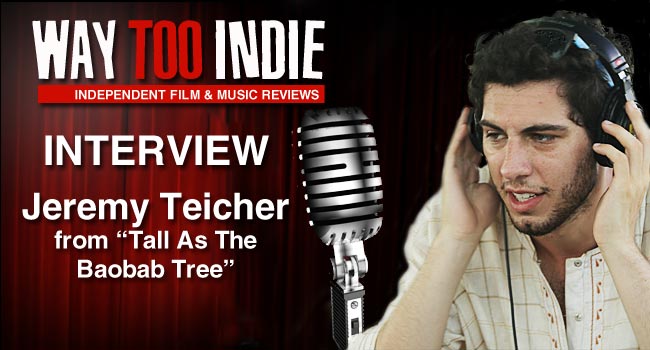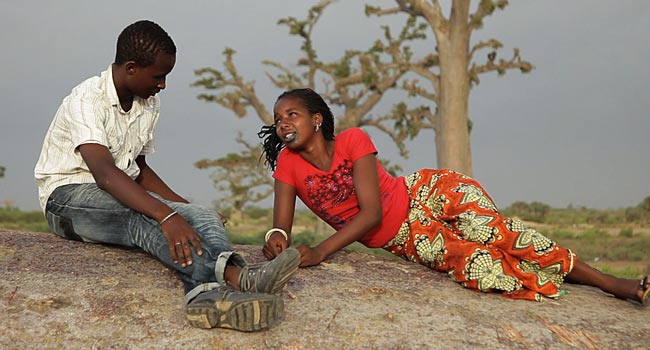Interview: Jeremy Teicher of Tall as the Baobab Tree

Tall as the Baobab Tree was one of my favorite films at the San Francisco International Film Festival, a serene, beautiful story about a Senegalese family torn between modernity and tradition. Director Jeremy Teicher took some time to chat with Way Too Indie about his inspiration behind the film, his amazing experience shooting it, how he wanted to depict Africa truthfully, stealing a shot from Quentin Tarantino, and more.
Where did the idea for the film come from?
Junior year in college, I had an off semester. I was studying film, theater, and English at Dartmouth, making short films…film student stuff. I had this opportunity through a non-profit to go to this school in a village in Senegal, which is where I’d end up working for years. [The gig was] they’d fly me out for two weeks, I’d cut and edit a video, they’d use it on their website. I said “Sure!” and going in, I did a lot of research watching specifically what types of documentary-style videos for non-profits have been made, and I saw that it was all really tear-jerking stuff where you feel pity and are inspired to give money, which is fine. But culturally, I felt that it very much ‘others’ them. It’s a very ‘other-ing’ sort of tactic to make you feel sorry for someone else and empathize with them.
I met these students at the school who were about my age—I was 19 and they were 16-17. A group of about fifteen of them were the first [kids in the village] to go to school. The village school was built in 2000—before that, there was no access point to education. No one ever went to school. It wasn’t even a thought in their minds. It was amazing to hear their stories, and that ended up being the focus for my film project for the non-profit—just capturing stories about their daily lives. I was inspired meeting them because they’re so determined and optimistic in the face of huge challenges. I felt inspired by them rather than feeling pity.
[I thought] it would be cool to make a documentary [since I’d never made one before]. It seemed like the right way to approach it, to capture their daily lives and put out a voice that showed the optimism and determination rather than the pity. I got funding through a fellowship, went back [to Senegal] and made This is Us.
[During] the course of making This is Us, Dior, who plays the main character [in Baobab], and I began talking about forced marriage, which is a lot of the reason why girls can’t go to school [there]. I had no idea this was happening. [This became] a big part of the documentary.
Coming-of-age stories [have always interested me]. [What I saw] in Senegal was quite the coming-of-age story. Imagine you wake up, go to school [in the city], and you don’t fit in because you’re from this remote village. Then, you come home, and you don’t fit in at home anymore because you’re the only one who has an education. You feel out of place. That’s a universal teenage feeling. [In Baobab], it’s put in an extreme context. These kids are a part of this big social and cultural change, [which makes it] an amazing coming-of-age story.
I think in narrative. I dream in narrative. I thought this would be an amazing narrative film to focus on the emotions [involved in] what’s going on, specifically on the issue of early marriage. Going back to the pity thing, forced early marriage is a huge international issue, and when we talk about it, we react with shock and disgust. “How could people possibly do this?” But what I saw in the village was that these aren’t evil people—everyone’s just doing what’s best for their family. So, how does early marriage happen when statistics show that it’s better to send girls to school? It’s a result of being between two worlds—the cultural, traditional world and the modern world—and not operating fully in either one. It’s this tragic situation, but if you have empathy with it rather than disgust towards it, I think that’s a better place to start when working toward social change.
What stood out about the film to me was how peaceful it is. There are profound issues being addressed, and there is conflict, but the film doesn’t feel intense in any way.
You look at Blood Diamond or War Witch, and what do you see? Guns, yelling, violence—what I would call sensationalism. I really wanted to make a film that brought people together, not with sensationalism, but with a sense of shared empathy and understanding. It’s cool because suddenly, you’re empathizing with the village elder. [He’s] condemning girls to early marriage, but you understand why. You don’t condone it, of course, but you understand it.
I wanted to make a film that captured [what I felt] when I was in the village—the pace of life there, the introspective conversations and shooting the shit that people do, the close bond between families. When these kids go to the city, they miss being at the village, even though they know the city is where the opportunities are. I wanted to capture that. That’s a big reason why the film is the way it is, why we didn’t have any plot twists for the sake of an exciting story. For me, it was really trying to capture truth as much as possible. I wanted to make a human film. I knew that it would be an important film for people working on this issue, but I wanted to make a film that anyone could have an emotional connection with, without using sensationalism.

What could you convey in a narrative feature that you couldn’t have in a documentary?
Firstly, it just felt natural—[in narrative] is just how I imagine stories. Specifically [for this film], I thought that narratively, I would be able to capture very specific moments and interactions that wouldn’t happen [in a documentary] unless [we recreated them.] Also, with narrative, you have the liberty to craft—in the editing and the music and the performance—these very specific moments. I think we were able to create empathy with the sisters using narrative because we could capture an intimate moment like them braiding each others’ hair. In a [documentary,] it might feel like you were observing rather than being a part of it. In narrative, we can capture these ultra-close-ups and capture the eye glances that make you feel like you’re there rather than observing.
Also, we had a lot of stories [from the kids] that we wanted to touch on, and we couldn’t touch on everything. With a narrative script, we could say “These are the experiences we want to highlight.” Artistically, it enables you to penetrate deeper into certain moments between characters, so you [understand] the relationships a lot better.
Talk about ‘C’est l’afrique!’
(laughs) It means “It’s Africa!” [in French]. Somebody would be two hours late [on the shoot], there would be a tree that fell across the road and they couldn’t show up to the shoot. ‘C’est l’afrique!’ [It was] basically the mantra of…you don’t have control over the environment and you have to let go. The American crew and I were trying to be super strict like on a shoot in the US, but you have to be adaptable.
There was no electricity [in the village], and at night it got pitch black. [At the end of the day, before it got dark] we’d take horses to the hotel and back with a cart to put all the [equipment] on. [One day, at the end of shooting] there were storm clouds on the horizon, and our cart got a flat tire. It started monsooning and getting dark at the same time, so we were stuck out in the village with all of our gear. It’s not the most secure place to be with thousands of dollars in film equipment. We had to cover [the equipment] with our bodies and wrap them up in our clothes. Finally, we had a horse come pick us up in the dark, but that was the craziest moment [of the shoot].
You’re only 24.
I was 22 when we started shooting, and had my 23rd birthday on set!
You’re very talented for being so young. What are some of your influences?
I appreciate the compliment for sure, but I credit very largely Chris Collins, my cinematographer who I hope to be able to work with forever. He’s the man. We went to high school together, [so] it’s an awesome relationship.
[At one point, making a feature film] seemed crazy, but I saw one film and thought to myself “Okay, I can do this.” It’s called Munyurangabo by Lee Isaac chung. It was shot in Rwanda on 16mm in a week or something with non-actors. That was a huge influence on Baobab. I got to meet Isaac, and he gave me a lot of advice, which was cool. Aesthetically, I drew some influence from PT Anderson. In There Will Be Blood, the landscape is a character.
We had a plot outline [for the film], but it was mostly just the beats of the scene, and the dialog was improvised. I don’t think I would have thought to do that unless I had seen a lot of the mumblecore films over the last ten years. Then there are just some directors and films I love. Woody Allen and Wes Anderson are close to my heart. I stole a shot from Quentin Tarantino (laughs).
Which shot?
There’s a shot from behind the village elder’s head. That’s the Marsellus Wallace shot. I thought “How do we make this guy seem powerful?” Pulp Fiction! (laughs)
Talk about how the experience has been showing Baobab across Europe and now in the US.
We’ve been doing the festival circuit since August to garner as much acclaim as possible. We did a lot in Europe and we played in the Middle East as well. [There’s been] great festival reception. I’ve seen audiences really respond to the film. We do a lot of educational screenings where kids are not choosing to watch the movie, and you think they might be bored to tears, but every time, most of the kids—in Paris, in Norway, here in San Francisco—are super engaged and identify with the characters.
For more information about the film, visit tallasthebaobabtree.com, and for information about forced marriage for girls, one of the main themes of Baobab, visit girlsnotbrides.org
